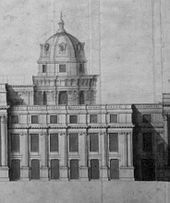Palace of Whitehall
The Palace of Whitehall ( German Whitehall Palace ) was the main residence of the British monarchs in London from 1530 . In 1698, a major fire destroyed the entire palace except for the Banqueting House. Before the fire, it was one of the largest palaces in Europe with more than 1,500 rooms.
The surrounding area and a street were named after the palace - Whitehall in the City of Westminster . Today the most important government agencies of the country are concentrated here.
At its greatest extent, the palace covered an area of around 93,000 m², which today extends from Northumberland Avenue in the north to Downing Street and Derby Gate in the south and from Horseguards Road in the west to the banks of the Thames in the east.
history


By the 13th century, the Palace of Westminster had become the center of English government. Since 1049 this palace had been the London residence of the English kings . The surrounding area soon became a very popular and also a very expensive residential area. Walter de Gray , the Archbishop of York , bought a house after 1240 and named it York Place .
Edward I (1272-1307) stayed in this building several times while work was being carried out at the Palace of Westminster. He had York Place expanded to accommodate his court. Cardinal Thomas Wolsey had the palace expanded to such an extent that it was soon the second largest building in all of London, surpassed only by Lambeth Palace , the London residence of the Archbishop of Canterbury . When King Henry VIII broke the power of the Catholic Cardinals in 1530, he acquired York Place and made it his new residence; a year earlier, part of the Palace of Westminster had been destroyed by fire.
Henry VIII had the palace completely redesigned and expanded several times. Inspired by the Richmond Palace , a recreational area was created with a bowling green , a tennis court, a pit for cockfighting (where Downing Street is now 10 ) and a court for jostling . It is estimated that during the 1540s over 30,000 pounds sterling were issued.
During the reign of Elizabeth I , the palace at Whitehall, which at that time was about an hour's walk from the nearest city gate, was the most frequently and longest-used residence of the court. Although the complex was called the Royal Palace, it actually looked more like a small town with buildings, squares, alleys and two gates. The individual buildings were not as such architecturally outstanding; the entire ensemble, as the largest palace complex in the world at the time, was particularly admired for the variety of its facilities with a tournament field, tennis courts and a cockfight arena as well as the precious interior furnishings. Every Londoner had the opportunity to watch what was going on at court, as a public road ran through the middle of the palace area.
Another expansion took place under James I , including the Banqueting House, which was built in 1622 according to plans by Inigo Jones . It houses the banquet hall and was completed in 1634. The ceiling painting is by Peter Paul Rubens . King Charles I was executed outside the Banqueting House in 1649. By 1650 the palace was the largest secular building complex in all of England and comprised more than 1,500 rooms. The floor plan was extremely irregular, the individual parts of the building were of different sizes and were built in different architectural styles. The palace was more like a small town.
Christopher Wren built a new chapel (1687), the Queen's Apartments (1688) and the Queen's Guest House (1689). In April 1691, a fire destroyed the oldest parts of the building complex. Another fire on January 4, 1698 destroyed almost the entire palace. No reconstruction took place due to empty state coffers; the cleared site was leased and released for the construction of townhouses.
What was left
The Banqueting House , built in 1622 to a design by Inigo Jones , is the only building that survived the major fire, but has since been rebuilt. From 1938, the new building of the Ministry of Defense was built on the eastern part of the site . Part of Thomas Wolsey's basement has been integrated into this building. Part of the marble carvings of the former Palace Chapel of Grinling Gibbons could be saved, was from 1706, first in the Westminster Abbey kept and the church then 1820 St. Andrew's from Burnham-on-Sea in Somerset integrated. n 1619,
Web links
Individual evidence
- ↑ Chris Carter: January 4, 1698: the Palace of Whitehall is destroyed by fire MoneyWeek.com, January 2, 2016, accessed July 31, 2020
- ^ Ulrich Suerbaum : The Elizabethan Age. Reclam, Ditzingen 1989, ISBN 3-15-008622-1 , p. 264 f.
- ↑ standrewsbos.org accessed on November 1, 2014 ( memento of October 29, 2016 in the Internet Archive )
Coordinates: 51 ° 30 ′ 16 " N , 0 ° 7 ′ 34" W.


